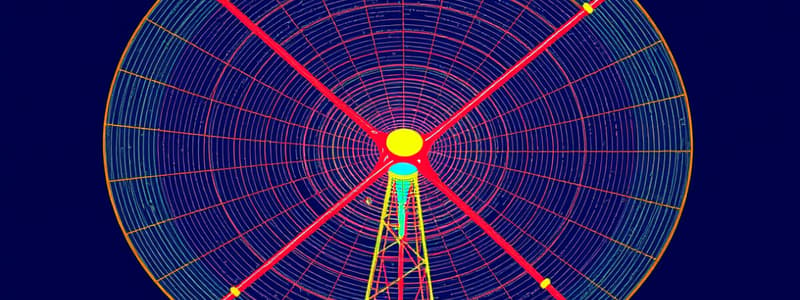Podcast
Questions and Answers
What is the primary advantage of using Electromagnetic Band Gap (EBG) structures in antenna design?
What is the primary advantage of using Electromagnetic Band Gap (EBG) structures in antenna design?
EBG structures significantly improve antenna gain and reduce return losses.
How does the use of Rogers RT/duroid 5880 substrate affect the performance of the microstrip patch antenna?
How does the use of Rogers RT/duroid 5880 substrate affect the performance of the microstrip patch antenna?
The substrate, with a relative permittivity of 2.2, contributes to better signal quality and improved gain.
Describe the dimensions of the patch in the planar antenna design presented.
Describe the dimensions of the patch in the planar antenna design presented.
The patch has a width of 15 mm and a length of 12 mm.
What are the overall lateral dimensions of the antenna, and why are they important?
What are the overall lateral dimensions of the antenna, and why are they important?
What role does the 50Ω SMA coaxial probe play in the antenna design?
What role does the 50Ω SMA coaxial probe play in the antenna design?
How does the planar antenna achieve its gain of 12.60 dB?
How does the planar antenna achieve its gain of 12.60 dB?
Explain the significance of achieving substantial performance enhancements specifically at the C-Band.
Explain the significance of achieving substantial performance enhancements specifically at the C-Band.
What factors contribute to the effective use of EBG materials in communication technologies?
What factors contribute to the effective use of EBG materials in communication technologies?
What is the primary purpose of the EBG structure in antenna design?
What is the primary purpose of the EBG structure in antenna design?
How does the proposed antenna utilize a coaxial probe in its design?
How does the proposed antenna utilize a coaxial probe in its design?
What material is used for the supports in the proposed EBG structure?
What material is used for the supports in the proposed EBG structure?
What antenna parameters are characterized in the paper?
What antenna parameters are characterized in the paper?
In which frequency band is the proposed antenna intended to operate?
In which frequency band is the proposed antenna intended to operate?
Why is parametric analysis important in the design of the EBG structure?
Why is parametric analysis important in the design of the EBG structure?
What method was used for the simulation of the proposed antenna design?
What method was used for the simulation of the proposed antenna design?
What are the potential applications of the enhanced antenna performance due to the EBG structure?
What are the potential applications of the enhanced antenna performance due to the EBG structure?
What role do Electromagnetic Band Gap (EBG) structures play in enhancing the performance of microstrip patch antennas?
What role do Electromagnetic Band Gap (EBG) structures play in enhancing the performance of microstrip patch antennas?
How do dual-band patch antennas utilizing EBG and SRR surfaces impact wearable technology?
How do dual-band patch antennas utilizing EBG and SRR surfaces impact wearable technology?
Discuss the significance of the 3D radiation pattern in the analysis of antenna performance.
Discuss the significance of the 3D radiation pattern in the analysis of antenna performance.
What advantages do high gain and wide band EBG resonator antennas offer for X-band applications?
What advantages do high gain and wide band EBG resonator antennas offer for X-band applications?
Explain how dual-layer dielectric superstrates contribute to the performance of EBG antennas.
Explain how dual-layer dielectric superstrates contribute to the performance of EBG antennas.
What is the effect of integrating EBG structures in the design of patch antennas for wireless sensor networks?
What is the effect of integrating EBG structures in the design of patch antennas for wireless sensor networks?
Identify the primary focus of the paper discussed in the content on mushroom-like EBG structures.
Identify the primary focus of the paper discussed in the content on mushroom-like EBG structures.
What can be inferred about the evolution of antenna design from the studies cited in the content?
What can be inferred about the evolution of antenna design from the studies cited in the content?
Flashcards are hidden until you start studying
Study Notes
Antenna Design and Performance
- A high-gain planar antenna design utilizes Ansys HFSS simulation software, focusing on improving gain through Electromagnetic Band Gap (EBG) structures.
- Features Rogers RT/duroid 5880 substrate with a relative permittivity of 2.2, which enhances gain and reduces return losses significantly.
- The proposed antenna achieves a gain of 12.60 dB, making it effective for C-Band applications, especially in radar and satellite communication.
Antenna Configuration
- The antenna configuration includes a rectangular patch etched on the substrate.
- Dimensions of the patch are width (Wpatch) = 15 mm and length (Lpatch) = 12 mm.
- Overall antenna dimensions are L = 184 mm and w = 40 mm, with a substrate thickness of 1.57 mm and a loss tangent (tan δ) of 0.0009.
- Fed by a 50Ω SMA coaxial probe, enabling better signal transmission.
Significance of EBG Structures
- EBG materials significantly control the propagation of electromagnetic waves, essential for enhancing antenna performance.
- Innovations in EBG design allow for reduced interference, promoting clearer signal transmission in communication technologies.
Conclusion and Implications
- The study successfully demonstrates the integration of EBG structures within antenna designs, leading to improved gain and minimized return loss.
- The advancements contribute to increased efficiency in utilizing the electromagnetic spectrum, fulfilling the demand for higher data rates and enhanced signal quality in modern communication systems.
Studying That Suits You
Use AI to generate personalized quizzes and flashcards to suit your learning preferences.




